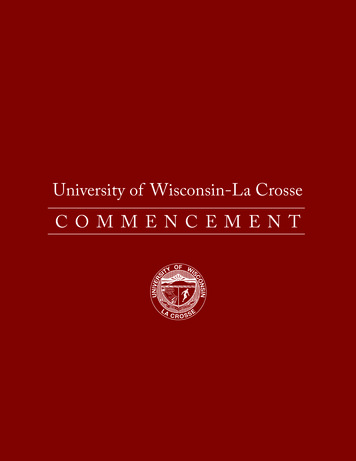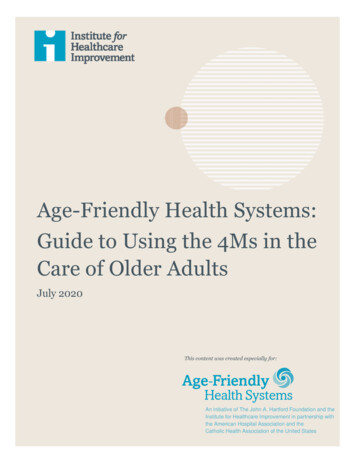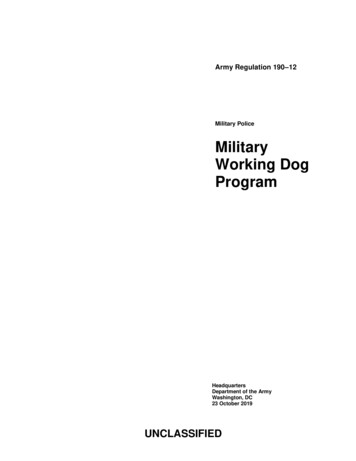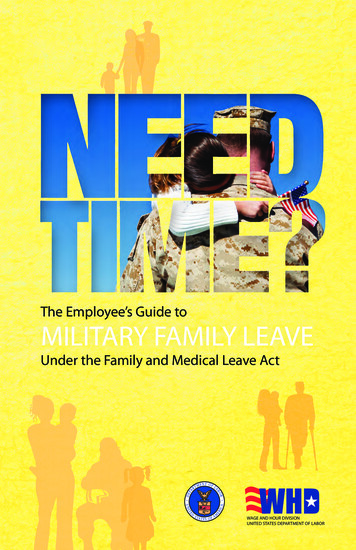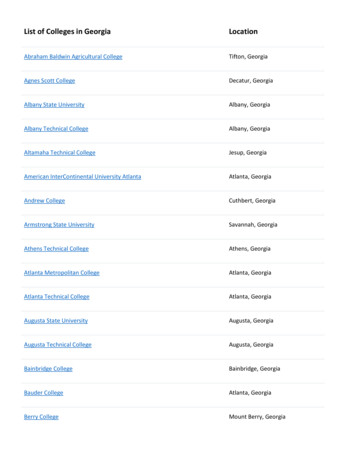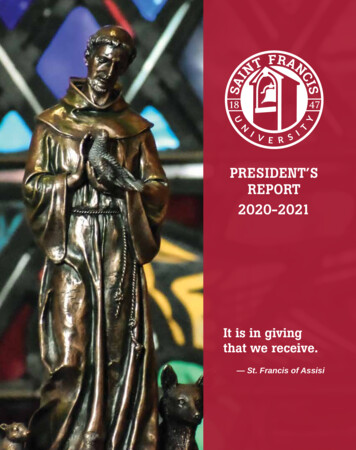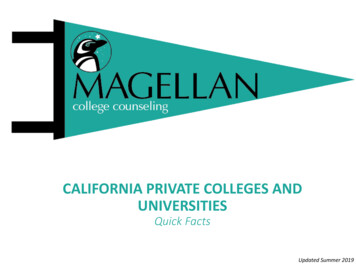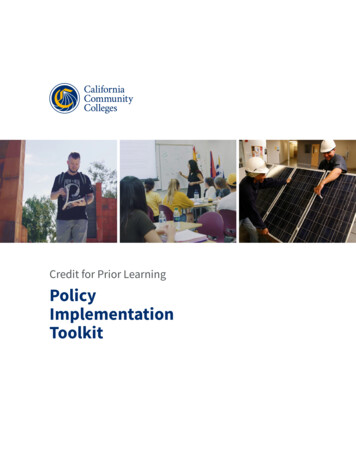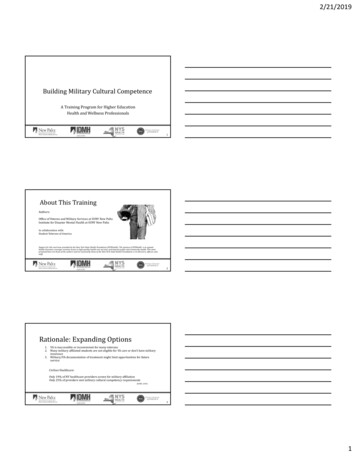
Transcription
3JPJournal of Progressive Policy & PracticedVolume 2 – Issue 2Summer 2014Do Community Colleges’ Military-FriendlyDesignations Make a Difference?A Propensity Score Adjustment AnalysisJudie A. HeinemanSan Diego State UniversityThe term military-friendly is used increasingly to describe colleges that embracepractices that recognize the unique needs of student-veterans. Through the use of twoway analysis of variance (factorial ANOVA), this exploratory study examined if therewere differences between students (non-veteran and veteran) and colleges’ designation(registered or not-registered as military-friendly) on students’ perceptions of validation,welcomeness, and belonging from faculty in the community college. Using data from theCommunity College Survey of Men (CCSM ), this study found that students reportedlower scores for faculty validation at military-friendly community colleges. Moreover,faculty belonging scores were significantly lower for student-veterans despite thecolleges’ military-friendly designation. Findings suggest that more can be done bycommunity college leaders to assist student-veterans in their academic success. As such,this exploratory study offers recommendations to achieve this objective.INTRODUCTIONAlmost two million U.S. soldiers, sailors, airmen, and Marines have returned home fromwartime service looking for new opportunities (Lighthall, 2012; O’Herrin, 2011). Manyreturning veterans will turn to higher education to enhance their employment prospects, expandtheir knowledge and skill sets, and achieve their career goals (McBain, Kim, Cook, & Snead,2012). Scholars have estimated that 43% of students who served in the military and who decideto attend college will do so at public two-year institutions (often referred to as communitycolleges) (Radford, 2011; Wheeler, 2012). These veterans have joined the student body usingthe most comprehensive educational package provided by the U.S. government since the originalGI Bill of 1944 (McBain et al., 2012; O’Herrin, 2011; Rumann, Rivera, & Hernandez, 2011). Assuch, community colleges are gearing up to handle this resulting influx of nontraditional students– the student-veteran (DiRamio & Jarvis, 2011; O’Herrin, 2011; Rumann & Hamrick, 2009;Rumann et al., 2011). By establishing a welcoming environment and providing a strong system 2014, Heineman147
of support, college leaders can have a positive effect on the integration and overall collegiateexperience of these students (Kim & Cole, 2013).A Contextual Understanding of Veteran StudentsThe National Center for Education Statistics (NCES) has noted that multiple studentgroups are encompassed among those classified as non-traditional students (Hamrick & Rumann,2013). Veterans are among those students typically classified as ‘non-traditional’ students. Theyare likely to be male, non-white, over the age of 24, married, financially independent, and havedelayed entry into college (Hamrick & Rumann, 2013; McBain et al., 2012; Radford, 2009;Wheeler, 2012; Wirt & Jaeger, 2014). In addition, many veterans are considered transfer studentsbecause they often bring with them academic credit earned through their military service(O’Herrin, 2011).Understanding that the student-veteran population can have different needs than otheradult learners (e.g., combat related mental and physical health issues, stress management andsocial adjustment issues, a strong sense of independence and self-reliance, and transition copingchallenges), scholars have suggested that colleges require a commitment to assist studentveterans as well as a dedicated approach to serving them (DiRamio, Ackerman, & Mitchell,2008; DiRamio & Jarvis, 2011; O’Herrin, 2011; Persky & Oliver, 2010; Rumann et al., 2011;Wheeler, 2012). Despite this recognition, McBain, Kim, Cook, and Snead (2012) reported thatonly 37 percent of postsecondary institutions serving student-veterans provide transitionassistance. Moreover, only 47 percent of institutions that serve student-veterans provide trainingopportunities for both faculty and staff to better enable them to assist veterans with transitionissues (McBain et al., 2012).Faculty members play a key role in how student-veterans perceive the campusenvironment (Rumann et al., 2011; Wheeler, 2012). Specifically, student-veterans in two studiesreported that faculty members were a key source of support, especially if the faculty had ties tothe military either through their own service or that of a family member (Rumann, 2010;Rumann et al., 2011). However, some faculty can be perceived as less supportive and, in someinstances, be viewed as disrespectful if they have made anti-war comments in class (DiRamio etal., 2008; Persky & Oliver, 2010; Rumann et al., 2011). Additionally, faculty-student interactionhas been connected to enriching students’ academic experiences in college and enhancing theirsuccess (Wirt & Jaeger, 2014). Thus, supportive, positive student-faculty relationships are keyto promoting veteran success at military-friendly community colleges.The term military-friendly is used to describe colleges that embrace practices thatrecognize the unique needs and characteristics of student-veterans. President Obama, throughExecutive order 13607, sought to codify specific ways colleges can support veterans as theypursue higher educational goals (Obama, 2012; U.S. Department of Education, 2013). Buildingupon this effort, the Departments of Veterans Affairs and Education created a joint programcalled the “8 Keys to Veterans’ Success.” This program allows college leaders to register theircampuses with a ‘military-friendly’ designation with the Department of Education if theycommit to implementing programs to:1. Create a culture of trust and connectedness across the campus community to promotewell-being and success for veterans.2. Ensure consistent and sustained support from campus leadership 2014, Heineman148
3. Implement an early alert system to ensure all veterans receive academic, career, andfinancial advice before challenges become overwhelming4. Coordinate and centralize campus efforts for all veterans, together with the creation ofa designated space (even if the space is limited in size).5. Collaborate with local communities and organizations, including government agencies,to align and coordinate various services for veterans.6. Utilize a uniform set of data tools to collect and track information on veterans,including demographics, retention and degree completion.7. Provide comprehensive professional development for faculty and staff on issues andchallenges unique to veterans.8. Develop systems that ensure sustainability of effective practices for veterans. (U.S.Department of Education, 2013, p. 1).According to Brown and Gross (2011), being designated as a military-friendly institution is anhonor that speaks to student-centered practices and service-oriented commitment. By creating aculture of trust, providing sensitivity training to faculty, and developing sustainable effectivepractices, college leaders can enhance the campus climate making it more welcoming to studentveterans (Wheeler, 2012). There is an expectation that the military friendly designation willmake a difference for student-veterans; however, research is needed to corroborate thisexpectation.Bearing the aforementioned in mind, this exploratory study examined if there weredifferences between students (non-veterans and veterans) and their perceptions of facultywelcomeness, validation, and belonging in consideration of the college’s military-friendlydesignation (registered and not-registered as military-friendly). This research also examinedinteractions between the students’ veteran status and the community colleges’ military-friendlydesignation. Understanding that colleges are making efforts to welcome veterans, it ishypothesized that there will be greater perceptions of faculty welcomeness, validation, andbelonging for student-veterans attending community colleges which are registered as militaryfriendly. This would be reflected in greater scores for these three outcomes.METHODSData for this exploratory study were derived from the Community College Survey ofMen (CCSM ). The CCSM is a survey designed by the Minority Male Community CollegeCollaborative (M2C3) as a comprehensive needs assessment tool for evaluating male studentsuccess in community colleges focusing on men who have been historically underrepresentedand underserved in higher education ("About the Community College Survey of Men," n.d.).Although the CCSM has been completed by over 7,000 men at 40 community colleges acrossthe country (Wood & Harris III, 2013), this study’s dataset was restricted to a subset of urbanmen (N 206). Half of the respondents self-identified as military veterans with the remainingrespondents noting no prior military service.The outcome variables employed in this study were faculty belonging, facultywelcomeness, and faculty validation. Faculty belonging assessed students’ agreement thatfaculty communicated that students belonged in class and at the institution and that facultyvalued student interactions and their success (five items, a .96). Faculty welcomenessmeasured the degree to which faculty members welcomed students’ engagement in attending 2014, Heineman149
office hours, ascertaining their coursework progress, and asking and answering questions in class(four items, a .84). Faculty validation evaluated students’ perceptions about the degree towhich faculty members communicated the students’ ability: to do the work; to succeed incollege; and the degree to which students belong at the institution (three items, a .92). The twoindependent variables employed in this study were student-veteran status and collegedesignation. The student-veteran status factor had two levels, veteran and non-veteran, as did thefactor for college designation (registered with the Department of Education as military-friendlyor not registered).Each student-veteran in the sample population was matched with a non-veteran studentusing propensity scores. Propensity scores were generated using respondent’s age, annualincome, number of dependents, enrollment status (part-time/full-time), number of stressful lifeevents in the past two years, high school GPA, college GPA, and the number of college creditscompleted (see Appendix). The propensity score was also used as a covariate in subsequentanalyses to adjust for potential effects of concomitant effects on the model (Austin, 2011; Rubin& Neal, 2000). Data were analyzed using 2 X 2 two-way analyses of variance (factorialANOVA). Three models were generated to assess the perceptions of faculty welcomeness(FWELCOME), faculty validation (FVALID), and faculty belonging (FBELONGING) for thestudent populations. Effect sizes were interpreted using partial eta squared (partial n2) withpartial n2 effect sizes of .01, .06, and .14 interpreted as small, medium, and large, respectively(Green & Salkind, 2011). Exploratory data analyses were conducted to ensure that ANOVA(e.g., normality, homogeneity) assumptions were met.The primary limitation of this study was its focus solely on male (veteran and nonveteran) students. Female veterans were not included in the dataset due to the nature of theCCSM . This is a significant limitation because women comprised nine percent of the totalveteran population in the United States in 2009 (1.5 million women). Moreover, the Departmentof Veterans Affairs projects that by 2035, women will account for over 15 percent of the veteranpopulation (National Center for Veterans Analysis and Statistics, 2011). Additionally, this studydid not address perceptions of students attending colleges in suburban or rural areas. The smallersample size and the propensity score matching resulted in a limited number of students attendingcolleges registered as military-friendly campuses.RESULTSThe first analysis examined if there was a greater sense of faculty welcomeness(FWELCOME) by students’ veteran status, military-friendly college designation status, and theinteraction of these factors. The main effects for student-veteran status (F .840, p n.s.),registration status (F .199, p n.s.), and the interaction effect for veteran status and collegedesignation (F .008, p n.s.) were not significant. Thus, student-veterans and non-veterans hada similar sense of welcomeness from the faculty. Designation as a military-friendly campus didnot have a statistically significant impact on student perceptions of welcomeness.Next, the second analysis explored if there was a greater sense of validation by thefaculty (FVALID). The main effect for registration status was significant, F 5.847, p .05. Thepartial eta squared indicated that the registration status accounted for 3% of the variance in theoutcome. This was a small-to-medium effect size. Bonferroni pairwise comparisons forregistration status showed that military-friendly registered colleges had lower mean scores (by1.58 points) than non-registered colleges; this difference was significant, p .05. As such, a 2014, Heineman150
military-friendly college designation appeared to have a negative impact on student perceptionsof faculty validation. The profile plot is shown in Figure 1.Finally, the third analysis explored students’ perceptions of sense of belonging by thefaculty (FBELONGING). The main effect for student-veteran status was statistically significant,F 8.621, p .01. The partial eta squared indicated that the student’s veteran status accountedfor 4% of the variance in the outcome, a small-to-medium effect. Bonferroni pairwisecomparisons for veteran status indicated significant differences showing that student-veteranshad lower mean scores (by 2.12 points) than non-student-veterans (p .01). This difference isdepicted in Figure 2.Figure 1: Profile plot showing student perceptions of faculty validationFigure 2: Profile plot showing student perceptions of faculty belonging 2014, Heineman151
In summary, this exploratory study found lower scores for faculty validation at schoolsregistered as military-friendly. Additionally, it found that student-veterans reported lower scoresthan non-veteran for their sense of belonging with faculty. No differences for facultywelcomeness were identified by military status or designation.DISCUSSIONAs previously mentioned, this study sought to examine if there were statisticallysignificant differences between students (non-veteran and veteran) and the colleges’ designationstatus (registered or not-registered as military-friendly) on students’ sense of facultywelcomeness, validation, and belonging. Both veterans and non-veteran students attending nonregistered and military-friendly colleges indicated a similar sense of welcomeness from thecommunity college faculty. Further, it was hypothesized that there would be a greater sense ofvalidation and belonging for student-veterans at military-friendly colleges. Two of the analysesindicated statistical significance for faculty validation and belonging. The model for validationshowed that at colleges registered as military-friendly, there was a lower sense of validation fromfaculty among student-veterans. This suggests that student-veterans do not sense that facultyregularly communicate that the student-veterans have the ability to do the work or to succeed incollege, at least in comparison to their non-veteran peers. In addition, the model for facultybelonging showed that student-veterans sensed a lower feeling of belonging. This indicated thatstudent-veterans did not feel that faculty perceived that they belonged at the community college,despite the college’s military-friendly designation. All of these results contradict the expectationsthat student-veterans attending a military-friendly community would feel a greater sense ofwelcomeness, validation, and belonging from the faculty.IMPLICATIONS AND CONCLUSIONThe findings from this study indicated that community colleges with the military-friendlydesignation have more to do to ensure student-veterans feel an enhanced sense of welcomeness,belonging, and validation. As previously mentioned, faculty members play a key role in howstudent-veterans perceive the campus environment, and positive perceptions of faculty have beendirectly connected to enriching students’ academic experiences in college and enhancing theirsuccess (Rumann et al., 2011; Wheeler, 2012; Wirt & Jaeger, 2014). The military-friendlydesignation was created to enable student veterans to make informed college selection decisions,but also serves as a marketing tool for colleges. Military-friendly community colleges couldprovide enhanced professional development training for faculty to include fostering positive andaffirming campus climates. This training could address and alleviate many of the faculty-centricissues discussed in this exploratory study. Additionally, campus-wide training could be initiatedfor faculty, staff, and students to raise awareness of issues that student-veterans encounter in thecommunity college environment. Finally, military-friendly colleges could be required to conductand publish results of student surveys assessing student-veteran satisfaction with the colleges’implementation of the 8 Keys to Veterans’ Success. These results could indicate to futurestudent-veterans the extent of the military-friendly climate at the college.According to Hamrick and Rumann (2013), serving those who have served is an honorand a privilege. By adjusting policy and implementing changes to accommodate the needs of thestudent-veteran, community colleges will make positive differences in the lives of the student- 2014, Heineman152
veterans they serve. Community colleges are well positioned to welcome this cadre of studentsnow and into the future – benefitting the college, the community, and veterans. By ensuringstudent-veterans feel a sense of welcomeness, belonging, and validation, community collegeleaders can enable student-veteran success, allowing them to experience enhanced outcomes incollege.REFERENCESAbout the Community College Survey of Men. (n.d.). Retrieved July 10, 2014, ject/ccsm/Austin, P. C. (2011). An introduction to propensity score methods for reducing the effects ofconfounding in observational studies. Multivariate Behavioral Research, 46(3), 399-424.DiRamio, D., Ackerman, R., & Mitchell, R. L. (2008). From combat to campus: Voices ofstudent-veterans. NASPA Journal, 45(1), 73-102.DiRamio, D., & Jarvis, K. (2011). Special Issue: Veterans in higher education -- When Johnnyand Jane come marching to campus. ASHE Higher Education Report, 37(3), 1-144. doi:10.1002/aehe.3703Green, S., & Salkind, N. J. (2011). Using SPSS for Windows and Macintosh: Analyzing andUnderstanding Data (6th ed.). Upper Saddle River, NJ: Pearson Education.Hamrick, F., & Rumann, C. (Eds.). (2013). Called to Serve: A Handbook on Student Veteransand Higher Education. San Francisco: John Wiley & Sons.Kim, Y. M., & Cole, J. S. (2013). Student veterans/service members' engagement in college anduniversity life and education. Washington, D.C.: American Council on Education.Lighthall, A. (2012). Ten things you should know about today's student veteran. Thought &Action, 28, 81-90.McBain, L., Kim, Y., Cook, B., & Snead, K. (2012). From soldier to student II: Assessingcampus programs for veterans and service members. Washington, DC: American Councilon Education.National Center for Veterans Analysis and Statistics. (2011). America's Women Veterans:Military service history and VA benefit utlization statistics. Washington, DC:Department of Veterans Affairs.O’Herrin, E. (2011). Enhancing veteran success in higher education. Peer Review, 13(1), 15-18.Obama, B. (2012). Executive Order -- Establishing Principles of Excellence for EducationalInstitutions Serving Service Members, Veterans, Spouses and Othe Family Members.Retrieved June 10, 2014, from nce-educational-institutiPersky, K. R., & Oliver, D. E. (2010). Veterans coming home to the community college: Linkingresearch to practice. Community College Journal of Research and Practice, 35(1-2), 111120. doi: 10.1080/10668926.2011.525184Radford, A. W. (2009). Military service members and veterans in higher education: What thenew GI Bill may mean for postsecondary institutions: American Council On Education.Radford, A. W. (2011). Military service members and veterans: A profile of those enrolled inundergraduate and graduate education in 2007-2008. Washington, DC: National Centerfor Education Statistics.Rubin, D. B., & Neal, T. (2000). Combining propensity score matching with additionaladjustments for prognostic covariates. Journal of the American Statistical Association,95(450), 573-585. 2014, Heineman153
Rumann, C. (2010). Student veterans returning to a community college: Understanding theirtransitions. (Doctor of Philosophy Dissertation), Iowa State University, Ames.Rumann, C., & Hamrick, F. (2009). Supporting student veterans in transition. New Directions forStudent Services(126), 25-34. doi: 10.1002/ss.313Rumann, C., Rivera, M., & Hernandez, I. (2011). Student veterans and community colleges. NewDirections for Community Colleges(155), 51-58. doi: 10.1002/cc.457U.S. Department of Education. (2013). President Obama applauds community colleges' anduniversities' efforts to implement 8 Keys to Veterans' Success [Press release]. Retrievedfrom forts-implement-8Wheeler, H. A. (2012). Veterans' transitions to community college: A case study. CommunityCollege Journal of Research and Practice, 36(10), 775-792. doi:10.1080/10668926.2012.679457Wirt, L. G., & Jaeger, A. J. (2014). Seeking to understand faculty-student interaction atcommunity colleges. Community College Journal of Research and Practice, 38(11), 980994.Wood, J. L., & Harris III, F. (2013). The Community College Survey of Men: An initialvalidation of the instrument's non-cognitive outcomes construct. Community CollegeJournal of Research and Practice, 37(4), 333-338.Correspondence regarding this article should be addressed to Judie A. Heineman, DoctoralStudent, Educational Leadership (Community College, Postsecondary Education), San DiegoState University, 5500 Campanile Drive, San Diego, CA 92182. Email: judie.heineman@cox.net 2014, Heineman154
APPENDIXVariables and Coding SchemaVariableFaculty WelcomenessValues4 to 24Faculty Validation3 to 18Faculty Belonging5 to 30Age1 Under 182 18 to 24 years old3 25 to 31 years old4 32 to 38 years old5 39 to 45 years old6 46 to 52 years old7 53 to 59 years old8 60 to 66 years old9 67 or olderAnnual Income1 Under 10,000;2 10,001-20,000;3 20,001-30,000;4 30,001-40,000;5 40,001-50,000;6 50,001-60,000;7 60,001-70,000;8 70,001-80,000;9 80,001-90,000;10 90,001-100,000;11 100,001-110,000;12 110,000 or moreIndividual itemCollege GPA1 No GPA yet; 2 0.0;3 0.1; 4 0.2; 5 0.3; 6 0.4;7 0.5; 8 0.6; 9 0.7;10 0.8; 11 0.9; 12 1.0;13 1.1; 14 1.2; 15 1.3;16 1.4;17 1.5; 18 1.6;19 1.7; 20 1.8; 21 1.9;22 2.0; 23 2.1; 24 2.2;25 2.3; 26 2.4;27 2.5;28 2.6; 29 2.7; 30 2.8;31 2.9; 32 3.0; 33 3.1;34 3.2; 35 3.3; 36 3.4;37 3.5; 38 3.6; 39 3.7;40 3.8; 41 3.9; 42 4.0;1 none; 2 1; 3 2; 4 3;5 4; 6 5 or more1 Full time; 2 Part-timeIndividual itemDependentsEnrollment Status 2014, HeinemanTypeComposite measure(a . 84)Composite measure(a .92)Composite measure(a .96)Individual itemOther4 items; 6 point scaleagreement3 items; 6 point scale5 items; 6 point scaleagreementIndividual itemIndividual item155
High school GPAStressful life events in thepast two yearsTotal Credits Completed 2014, Heineman1 0.5 - 0.9 (F to D)2 1.0 - 1.4 (D to C-)3 1.5 - 1.9 (C- to C)4 2.0 - 2.4 (C to B-)5 2.4 - 2.9 (B- to B)6 3.0 - 3.4 (B to A-)7 3.5 - 4.0 (A- to A)1 None; 2 1; 3 2; 4 3;5 4; 6 5; 7 6; 8 7 or moreIndividual item1 None yet; 2 1to 14credits; 3 15 to 29 credits;4 30 to 44 credits; 5 45 to60 credits; 6 61 or morecreditsIndividual itemIndividual item156
to promoting veteran success at military-friendly community colleges. The term military-friendly is used to describe colleges that embrace practices that recognize the unique needs and characteristics of student-veterans. President Obama, through Executive order 13607, sought to codify specific ways colleges can support veterans as they
